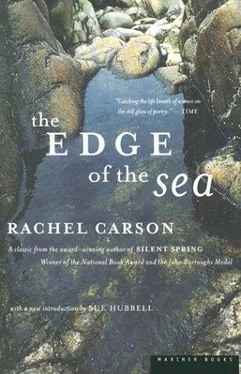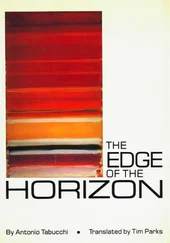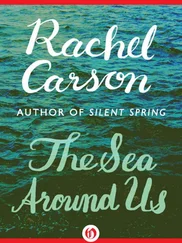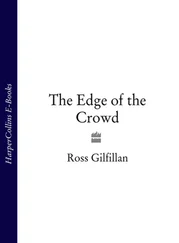Rachel Carson - The Edge of the Sea
Здесь есть возможность читать онлайн «Rachel Carson - The Edge of the Sea» весь текст электронной книги совершенно бесплатно (целиком полную версию без сокращений). В некоторых случаях можно слушать аудио, скачать через торрент в формате fb2 и присутствует краткое содержание. Город: Boston, Год выпуска: 1998, ISBN: 1998, Издательство: Mariner Books, Жанр: Биология, sci_ecology, sci_popular, на английском языке. Описание произведения, (предисловие) а так же отзывы посетителей доступны на портале библиотеки ЛибКат.
- Название:The Edge of the Sea
- Автор:
- Издательство:Mariner Books
- Жанр:
- Год:1998
- Город:Boston
- ISBN:978-0-395-07505-0
- Рейтинг книги:4 / 5. Голосов: 1
-
Избранное:Добавить в избранное
- Отзывы:
-
Ваша оценка:
- 80
- 1
- 2
- 3
- 4
- 5
The Edge of the Sea: краткое содержание, описание и аннотация
Предлагаем к чтению аннотацию, описание, краткое содержание или предисловие (зависит от того, что написал сам автор книги «The Edge of the Sea»). Если вы не нашли необходимую информацию о книге — напишите в комментариях, мы постараемся отыскать её.
A book to be read for pleasure as well as a practical identification guide,
introduces a world of teeming life where the sea meets the land. A new generation of readers is discovering why Rachel Carson’s books have become cornerstones of the environmental and conservation movements. New introduction by Sue Hubbell.
The Edge of the Sea — читать онлайн бесплатно полную книгу (весь текст) целиком
Ниже представлен текст книги, разбитый по страницам. Система сохранения места последней прочитанной страницы, позволяет с удобством читать онлайн бесплатно книгу «The Edge of the Sea», без необходимости каждый раз заново искать на чём Вы остановились. Поставьте закладку, и сможете в любой момент перейти на страницу, на которой закончили чтение.
Интервал:
Закладка:
Under water that was clear as glass the pool was carpeted with green sponge. Gray patches of sea squirts glistened on the ceiling and colonies of soft coral were a pale apricot color. In the moment when I looked into the cave a little elfin starfish hung down, suspended by the merest thread, perhaps by only a single tube foot. It reached down to touch its own reflection, so perfectly delineated that there might have been, not one starfish, but two. The beauty of the reflected images and of the limpid pool itself was the poignant beauty of things that are ephemeral, existing only until the sea should return to fill the little cave.
Whenever I go down into this magical zone of the low water of the spring tides, I look for the most delicately beautiful of all the shore’s inhabitants—flowers that are not plant but animal, blooming on the threshold of the deeper sea. In that fairy cave I was not disappointed. Hanging from its roof were the pendent flowers of the hydroid Tubularia, pale pink, fringed and delicate as the wind flower. Here were creatures so exquisitely fashioned that they seemed unreal, their beauty too fragile to exist in a world of crushing force. Yet every detail was functionally useful, every stalk and hydranth and petal-like tentacle fashioned for dealing with the realities of existence. I knew that they were merely waiting, in that moment of the tide’s ebbing, for the return of the sea. Then in the rush of water, in the surge of surf and the pressure of the incoming tide, the delicate flower heads would stir with life. They would sway on their slender stalks, and their long tentacles would sweep the returning water, finding in it all that they needed for life.
And so in that enchanted place on the threshold of the sea the realities that possessed my mind were far from those of the land world I had left an hour before. In a different way the same sense of remoteness and of a world apart came to me in a twilight hour on a great beach on the coast of Georgia. I had come down after sunset and walked far out over sands that lay wet and gleaming, to the very edge of the retreating sea. Looking back across that immense flat, crossed by winding, water-filled gullies and here and there holding shallow pools left by the tide, I was filled with awareness that this intertidal area, although abandoned briefly and rhythmically by the sea, is always reclaimed by the rising tide. There at the edge of low water the beach with its reminders of the land seemed far away. The only sounds were those of the wind and the sea and the birds. There was one sound of wind moving over water, and another of water sliding over the sand and tumbling down the faces of its own wave forms. The flats were astir with birds, and the voice of the willet rang insistently. One of them stood at the edge of the water and gave its loud, urgent cry; an answer came from far up the beach and the two birds flew to join each other.
The flats took on a mysterious quality as dusk approached and the last evening light was reflected from the scattered pools and creeks. Then birds became only dark shadows, with no color discernible. Sanderlings scurried across the beach like little ghosts, and here and there the darker forms of the willets stood out. Often I could come very close to them before they would start up in alarm—the sanderlings running, the willets flying up, crying. Black skimmers flew along the ocean’s edge silhouetted against the dull, metallic gleam, or they went flitting above the sand like large, dimly seen moths. Sometimes they “skimmed” the winding creeks of tidal water, where little spreading surface ripples marked the presence of small fish.
The shore at night is a different world, in which the very darkness that hides the distractions of daylight brings into sharper focus the elemental realities. Once, exploring the night beach, I surprised a small ghost crab in the searching beam of my torch. He was lying in a pit he had dug just above the surf, as though watching the sea and waiting. The blackness of the night possessed water, air, and beach. It was the darkness of an older world, before Man. There was no sound but the all-enveloping, primeval sounds of wind blowing over water and sand, and of waves crashing on the beach. There was no other visible life—just one small crab near the sea. I have seen hundreds of ghost crabs in other settings, but suddenly I was filled with the odd sensation that for the first time I knew the creature in its own world—that I understood, as never before, the essence of its being. In that moment time was suspended; the world to which I belonged did not exist and I might have been an onlooker from outer space. The little crab alone with the sea became a symbol that stood for life itself—for the delicate, destructible, yet incredibly vital force that somehow holds its place amid the harsh realities of the inorganic world.
The sense of creation comes with memories of a southern coast, where the sea and the mangroves, working together, are building a wilderness of thousands of small islands off the southwestern coast of Florida, separated from each other by a tortuous pattern of bays, lagoons, and narrow waterways. I remember a winter day when the sky was blue and drenched with sunlight; though there was no wind one was conscious of flowing air like cold clear crystal. I had landed on the surf-washed tip of one of those islands, and then worked my way around to the sheltered bay side. There I found the tide far out, exposing the broad mud flat of a cove bordered by the mangroves with their twisted branches, their glossy leaves, and their long prop roots reaching down, grasping and holding the mud, building the land out a little more, then again a little more.
The mud flats were strewn with the shells of that small, exquisitely colored mollusk, the rose tellin, looking like scattered petals of pink roses. There must have been a colony nearby, living buried just under the surface of the mud. At first the only creature visible was a small heron in gray and rusty plumage—a reddish egret that waded across the flat with the stealthy, hesitant movements of its kind. But other land creatures had been there, for a line of fresh tracks wound in and out among the mangrove roots, marking the path of a raccoon feeding on the oysters that gripped the supporting roots with projections from their shells. Soon I found the tracks of a shore bird, probably a sanderling, and followed them a little; then they turned toward the water and were lost, for the tide had erased them and made them as though they had never been.
Looking out over the cove I felt a strong sense of the interchangeability of land and sea in this marginal world of the shore, and of the links between the life of the two. There was also an awareness of the past and of the continuing flow of time, obliterating much that had gone before, as the sea had that morning washed away the tracks of the bird.
The sequence and meaning of the drift of time were quietly summarized in the existence of hundreds of small snails—the mangrove periwinkles—browsing on the branches and roots of the trees. Once their ancestors had been sea dwellers, bound to the salt waters by every tie of their life processes. Little by little over the thousands and millions of years the ties had been broken, the snails had adjusted themselves to life out of water, and now today they were living many feet above the tide to which they only occasionally returned. And perhaps, who could say how many ages hence, there would be in their descendants not even this gesture of remembrance for the sea.
The spiral shells of other snails—these quite minute—left winding tracks on the mud as they moved about in search of food. They were horn shells, and when I saw them I had a nostalgic moment when I wished I might see what Audubon saw, a century and more ago. For such little horn shells were the food of the flamingo, once so numerous on this coast, and when I half closed my eyes I could almost imagine a flock of these magnificent flame birds feeding in that cove, filling it with their color. It was a mere yesterday in the life of the earth that they were there; in nature, time and space are relative matters, perhaps most truly perceived subjectively in occasional flashes of insight, sparked by such a magical hour and place.
Читать дальшеИнтервал:
Закладка:
Похожие книги на «The Edge of the Sea»
Представляем Вашему вниманию похожие книги на «The Edge of the Sea» списком для выбора. Мы отобрали схожую по названию и смыслу литературу в надежде предоставить читателям больше вариантов отыскать новые, интересные, ещё непрочитанные произведения.
Обсуждение, отзывы о книге «The Edge of the Sea» и просто собственные мнения читателей. Оставьте ваши комментарии, напишите, что Вы думаете о произведении, его смысле или главных героях. Укажите что конкретно понравилось, а что нет, и почему Вы так считаете.












